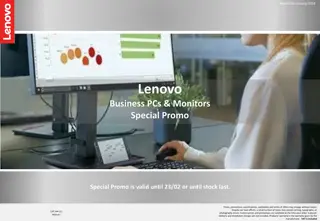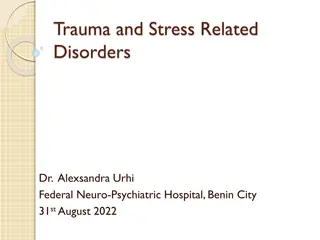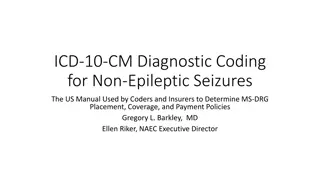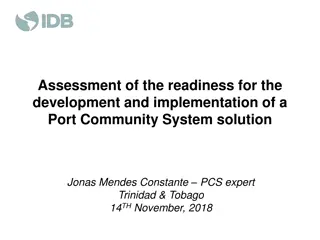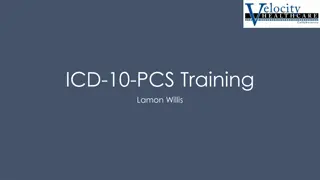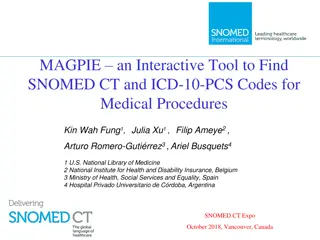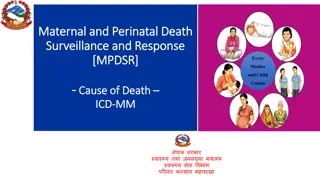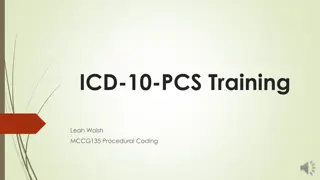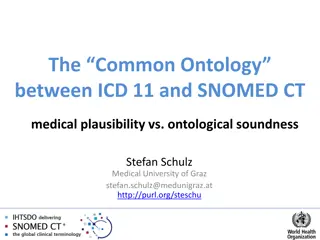ICD-10-PCS Bypass Operation by Stephanie Carlisto
Explore the world of ICD-10-PCS bypass procedures presented by Stephanie Carlisto, a seasoned RHIT and CCS-certified AHIMA-approved ICD-10 CM/PCS trainer. Gain valuable insights into this vital aspect of medical coding and enhance your knowledge in the field.
Download Presentation

Please find below an Image/Link to download the presentation.
The content on the website is provided AS IS for your information and personal use only. It may not be sold, licensed, or shared on other websites without obtaining consent from the author.If you encounter any issues during the download, it is possible that the publisher has removed the file from their server.
You are allowed to download the files provided on this website for personal or commercial use, subject to the condition that they are used lawfully. All files are the property of their respective owners.
The content on the website is provided AS IS for your information and personal use only. It may not be sold, licensed, or shared on other websites without obtaining consent from the author.
E N D
Presentation Transcript
Root Operation ICD-10-PCS BYPASS Presented by Stephanie Carlisto, RHIT, CCS AHIMA Approved ICD-10 CM/PCS Trainer
Root Operation Guidelines B3.1a Full definition B3.1b Integral to procedure B3.2 Multiple procedures B3.3 Discontinued procedures B3.4 Biopsy followed by treatment B3.5 Overlapping body layers 2
Guideline A. 11. Many of the terms used to construct PCS codes are defined within the system. It is the coder s responsibility to determine what the documentation in the medical record equates to in the PCS definitions. The physician is not expected to use the terms used in PCS code descriptions, nor is the coder required to query the physician when the correlation between the documentation and the defined PCS terms is clear. Example: When the physician documents partial resection, the coder can independently correlate partial resection to the root operation Excision without querying the physician for clarification. 3
Guidelines B3. Root Operation General guidelines B3.1a In order to determine the appropriate root operation, the full definition of the root operation as contained in the PCS Tables must be applied. B3.1b Components of a procedure specified in the root operation definition and explanation are not coded separately. Procedural steps necessary to reach the operative site and close the operative site are also not coded separately. Example: Resection of a joint as part of a joint replacement procedure is included in the root operation definition of Replacement and is not coded separately. Laparotomy performed to reach the site of an open liver biopsy is not coded separately.
Guidelines B3. Root Operation Multiple procedures B3.2 During the same operative episode, multiple procedures are coded if: a. The same root operation is performed on different body parts as defined by distinct values of the body part character. Example: Diagnostic excision of liver and pancreas are coded separately. b. The same root operation is repeated at different body sites that are included in the same body part value. Example: Excision of the sartorius muscle and excision of the gracilis muscle are both included in the upper leg muscle body part value, and multiple procedures are coded. c. Multiple root operations with distinct objectives are performed on the same body part. Example: Destruction of sigmoid lesion and bypass of sigmoid colon are coded separately. d. The intended root operation is attempted using one approach, but is converted to a different approach. Example: Laparoscopic cholecystectomy converted to an open cholecystectomy is coded as percutaneous endoscopic Inspection and open Resection.
Guidelines Discontinued procedures B3.3 If the intended procedure is discontinued, code the procedure to the root operation performed. If a procedure is discontinued before any other root operation is performed, code the root operation Inspection of the body part or anatomical region inspected. Example: A planned aortic valve replacement procedure is discontinued after the initial thoracotomy and before any incision is made in the heart muscle, when the patient becomes hemodynamically unstable. This procedure is coded as an open Inspection of the mediastinum.
Guidelines Biopsy followed by more definitive treatment B3.4 If a diagnostic Excision, Extraction, or Drainage procedure (biopsy) is followed by a more definitive procedure, such as Destruction, Excision or Resection at the same procedure site, both the biopsy and the more definitive treatment are coded. Example: Biopsy of breast followed by partial mastectomy at the same procedure site, both the biopsy and the partial mastectomy procedure are coded. Overlapping body layers B3.5 If the root operations Excision, Repair or Inspection are performed on overlapping layers of the musculoskeletal system, the body part specifying the deepest layer is coded. Example: Excisional debridement that includes skin and subcutaneous tissue and muscle is coded to the muscle body part.
ICD-10-PCS Root Operations Character 4 Character 5 Character 1 Character 2 Character 3 Character 6 Character 7 Section Body System Root Body Part Approach Device Qualifier Operation Objective of procedure 31 Root operations Arranged by similar attributes Multiple codes Examples of Root operations: Bypass Drainage Reattachment Resection Inspection 8
Bypass Root Operation 1 Altering the route of passage of the contents of a tubular body part Bypass 1 Definition Rerouting content of a body part to a downstream area of the normal route, to a similar route and body part, or to an abnormal route and dissimilar body part. Includes one or more anastomoses, with or without the use of a device Explanation Coronary artery bypass graft, colostomy formation Examples
Bypass Root Operation 1 Tracheostomy formation with tracheostomy tube placement Shunting of intrathecal cerebrospinal fluid to peritoneal cavity using synthetic shunt Gastrojejunostomy Colostomy Aortocoronary Bypass
Guidelines Bypass procedures B3.6a Bypass procedures are coded by identifying the body part bypassed from and the body part bypassed to. The fourth character body part specifies the body part bypassed from, and the qualifier specifies the body part bypassed to. Example: Bypass from stomach to jejunum, stomach is the body part and jejunum is the qualifier. B3.6b Coronary arteries are classified by number of distinct sites treated, rather than number of coronary arteries or anatomic name of a coronary artery (e.g., left anterior descending). Coronary artery bypass procedures are coded differently than other bypass procedures as described in the previous guideline. Rather than identifying the body part bypassed from, the body part identifies the number of coronary artery sites bypassed to, and the qualifier specifies the vessel bypassed from. Example: Aortocoronary artery bypass of one site on the left anterior descending coronary artery and one site on the obtuse marginal coronary artery is classified in the body part axis of classification as two coronary artery sites and the qualifier specifies the aorta as the body part bypassed from.
Guidelines B3.6c If multiple coronary artery sites are bypassed, a separate procedure is coded for each coronary artery site that uses a different device and/or qualifier. Example: Aortocoronary artery bypass and internal mammary coronary artery bypass are coded separately.
Bypass Root Operation 1 CABG Body part # of sites Qualifier Bypassed to
Device for Bypass Types of Grafts Autologous Synthetic Substitute Non Autologous Tissue Substitute
Bypass Root Operation 1 Non Coronary Coronary Body Part Body Part From # Of Sites Qualifier Qualifier To From
Bypass Root Operation 1 Body part is abdominal aorta (0) and Qualifier is Femoral Arteries, Bilateral (K)
Looking up the code Go to the index and look up bypass Coronary Four or more sites 0213 One site 0210 Three sites 0212 Two sites 0211
Finding the code Use the numbers given in the index to find the table you will use to build your code Look for: 0 Medical Surgical (section) 2 Heart and Great Vessels (body system) 1 Bypass (root operation)
Finding the code 0 Medical and Surgical 2 Heart and Great Vessels 1 Bypass altering the route of passage of a tubular body part Body Part Character 4 Approach Character 5 Device Character 6 Qualifier Character 7 0 Coronary Artery, one site 1 Coronary Artery, two sites 2 Coronary Artery, three sites 3 Coronary Artery, four or more sites 0 Open 4 Percutaneous 9 Autologous Venous Tissue A Autologous Arterial Tissue J Synthetic Substitute K Non Autologous Tissue Substitute 3 Coronary Artery 8 Internal Mammary, Right 9 Internal Mammary, Left C Thoracic Artery F Abdominal Artery W Aorta
Procedure code Coronary artery bypass, two sites, open approach, autologous venous tissue to the aorta 021109W


